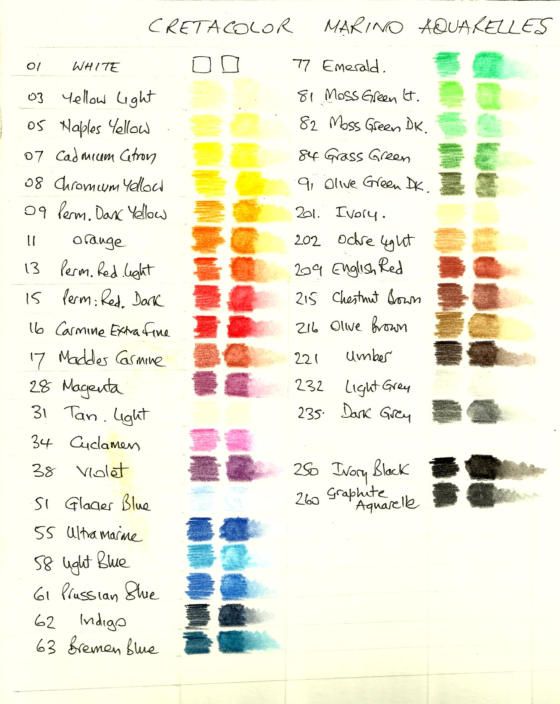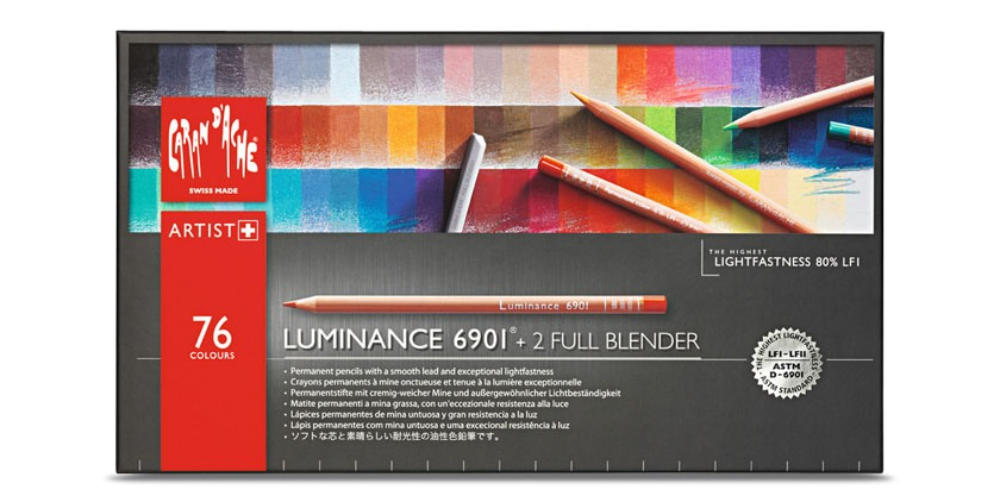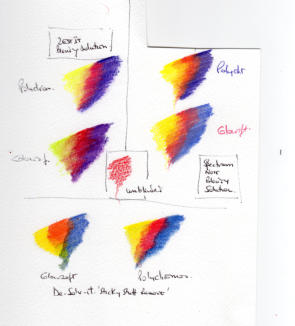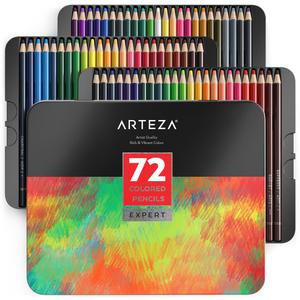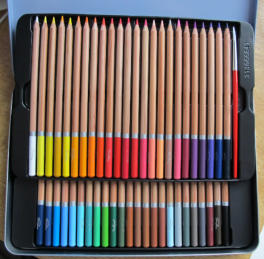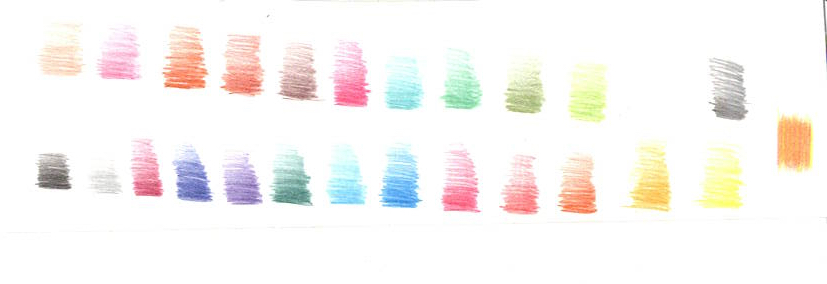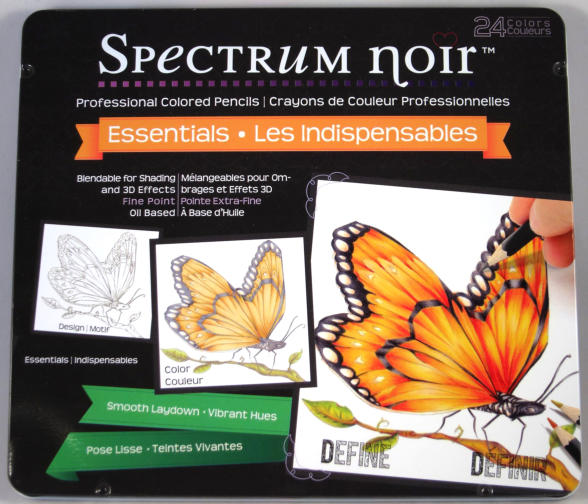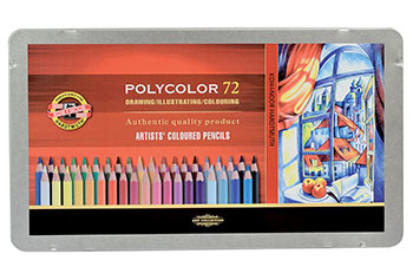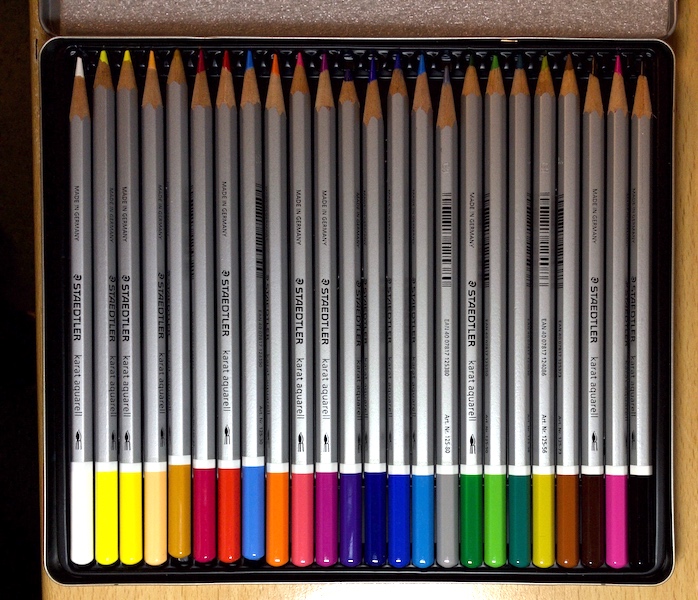A Practical Guide to Fixative Sprays for Coloured Pencil and Pastel Artists
As artists, we pour so much time, effort, and heart into our drawings.
Whether it's a vibrant coloured pencil piece or a soft pastel pencil creation, naturally, we want to protect our finished artwork and sometimes even enhance its appearance or allow us to keep working on it.
This is where artist fixative sprays can become a valuable tool in your studio.
However, the world of fixatives can seem a little confusing at first.
- Which one should you choose?
- How do you apply it correctly?
- And most importantly, how can you be sure it will help, not harm, your precious artwork?
Don't worry! This guide is here to demystify artist fixatives.
We'll walk through what they are, why they're used, the different types available, how to select the right one for your needs, and crucially, how to apply them safely and effectively.
With a little understanding and careful testing, fixatives can be a brilliant addition to your artistic toolkit.
What is Artist Fixative and Why Might You Use It?
At its simplest, an artist fixative is a clear liquid solution, usually applied as a fine spray, that creates a thin, protective film over the surface of your dry media artwork (like coloured pencil, graphite, charcoal, or pastel pencil drawings).
The primary goal is to stabilize the pigment particles on the paper.
But beyond just basic protection, here are several key reasons why you, as a pencil artist, might choose to use a fixative:
To Prevent Smudging & Smearing
This is especially important for softer mediums like pastel pencils or charcoal, but even heavily layered coloured pencil work can be prone to smudging if not protected. A fixative helps to bind the loose pigment to the paper.
To Allow for More Layers (Workable Fixative)
Have you ever worked an area so much with coloured pencils that the paper just won't take any more pigment?
This is often because the paper's tooth is full. A light coat of workable fixative can create a new, slightly textured surface, allowing you to add further layers of colour on top.
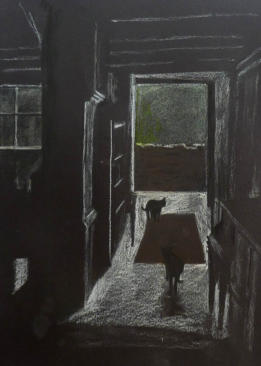 An excellent example of using fixative as a working tool: This pastel pencil sketch on black paper by Peter Weatherill has been fixed to seal the initial layer, preparing it for further coloured pencil work or other media.
An excellent example of using fixative as a working tool: This pastel pencil sketch on black paper by Peter Weatherill has been fixed to seal the initial layer, preparing it for further coloured pencil work or other media.To Manage and Prevent Wax Bloom
For those of us who love using wax-based coloured pencils, fixative is a key tool in managing and preventing wax bloom (that hazy film that can appear). It can seal the wax layers and stop the bloom from forming or recurring.
(We talk about this in detail on our wax bloom page.)
To Provide a Final Protective Seal (Final Fixative)
Once your artwork is complete, a final fixative creates a durable topcoat that protects against dust, moisture (to some extent), and heavily burnished coloured pencil surfaces.
To Offer UV Protection
Some final fixatives also contain UV light inhibitors, which can help protect your artwork's colours from fading over time due to light exposure, thus enhancing its longevity.
To Subtly Alter the Surface Sheen
Fixatives come in different finishes, commonly matte or satin (and occasionally gloss). Using a matte fixative can help reduce unwanted shine from waxy pencils, while a satin finish might slightly deepen colours. This effect is usually subtle but can be a consideration.
While many fixatives were initially developed for mediums like pastel or charcoal, understanding their properties allows coloured pencil artists to select and use them effectively too.
The golden rule, however, is always test first!
Applying any liquid to your artwork carries a small risk, so making sure it's compatible with your specific pencils and paper is a step you should never skip. We'll cover testing in more detail shortly.
Understanding Types of Fixatives
Once you start looking at artist fixatives, you'll notice a few key terms that describe their purpose and how they work. Understanding these will help you pick the best option for your project.
Workable Fixative
What it is:
As the name suggests, a workable fixative lightly "fixes" or stabilizes the pigment on your paper, but it's designed to allow you to restore tooth and continue with your coloured pencil layering.
When to use it:
- If you've applied several layers of coloured pencil and the surface has become too slick or "toothy" to accept more colour easily, a light coat of workable fixative can provide a fresh surface with a bit more grip.
- To prevent smudging of underlayers while you work on subsequent layers.
- If you anticipate needing to manage wax bloom during the drawing process (especially with wax-based pencils).
Key Characteristic:
It dries to a surface that you can still draw or paint over, although it might subtly change the feel of the paper. It's not intended as a final, heavy-duty protective coat.
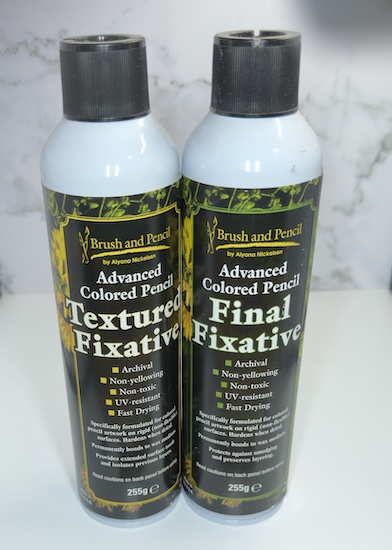 Some specialist brands, like Brush and Pencil by Alyona Nickelsen, offer distinct fixatives for different stages: a 'Textured Fixative' (left) to add tooth and act as a workable fixative, and a 'Final Fixative' (right) for sealing completed artwork.
Some specialist brands, like Brush and Pencil by Alyona Nickelsen, offer distinct fixatives for different stages: a 'Textured Fixative' (left) to add tooth and act as a workable fixative, and a 'Final Fixative' (right) for sealing completed artwork.Final Fixative:
What it is:
This type of fixative is applied when your artwork is completely finished, and you don't intend to do any more work on it.
When to use it:
To provide a permanent, protective seal over your completed drawing or painting.
Key Characteristic:
It creates a more durable, non-porous surface that helps protect against dust, moisture (to a degree), smudging, and sometimes UV light. It's generally not designed to be drawn over.
UV Protection:
Some final fixatives also include UV inhibitors or absorbers.
These are a fantastic feature if you're concerned about your artwork fading over time due to exposure to light.
If longevity and colour stability are high priorities, look for this on the label.
Surface Sheen (Matte, Satin, Gloss):
Fixatives can also alter the final sheen of your artwork. The product label will usually indicate the type of finish. It's important to choose based on whether you're still working on the piece or if it's a final protective coat you're after.
- Matte Finish: This is often the most popular choice for pencil work as it provides protection without adding shine, keeping the look of the original drawing. It can also help reduce any natural sheen from heavily applied wax pencils.
- Satin Finish: Offers a slight sheen, which can sometimes enhance the depth and richness of colours.
- Gloss Finish: Gives a shiny, varnish-like appearance. This is less commonly used for traditional pencil work but might be desired for specific mixed-media effects.
How to Choose the Right Fixative for Your Needs
With different types available, how do you pick the fixative that's best for your specific situation? Here are some key factors to consider.
Your Drawing Medium:
- Wax-Based Coloured Pencils: If you're using these (like Prismacolor Premier or many Derwent pencils), you might want a workable fixative to help manage tooth and wax bloom during layering, or a final fixative to seal the piece and prevent bloom long-term.
- Oil-Based Coloured Pencils: These are less prone to wax bloom, so fixative use is more often for final protection, UV resistance, or occasionally creating more tooth if the surface becomes slick.
- Pastel Pencils (and Soft Pastels): These mediums are very powdery and almost always benefit from fixing to prevent smudging, both during the process (workable) and for final protection.
- Graphite/Charcoal: Similar to pastels, these smudge easily and are often fixed.
Your Paper Type:
Most artist-quality papers will accept fixative well, but very thin or delicate papers might be more prone to buckling if a solvent-based fixative is applied too heavily.
Always test on a scrap of the same paper first.
The Stage of Your Artwork:
- As we discussed under 'Types of Fixatives,' your primary decision here is whether you need a Workable Fixative (if your piece is still in progress) or a Final Fixative (if it's completely finished).
- This is the most critical distinction!
Desired Final Appearance:
Referencing the different surface sheens mentioned earlier (matte, satin, or gloss), decide what overall look you prefer for your finished piece and check product labels for this information.
Archival Quality:
For artwork you want to last, look for fixatives that are labelled "archival." This generally means they are acid-free and designed not to yellow or degrade your artwork over time.
Read Product Labels and Manufacturer Recommendations VERY Carefully!
This is your best source of information.
The label will tell you what the fixative is designed for, which surfaces it's suitable for, drying times, safety precautions, and whether it's workable or final.
Different brands and product lines within brands can have different properties.
And (You Guessed It!) Always Test First:
I can't stress this enough.
Before applying any fixative to a piece you've spent hours on, spray a test sample.
Use the same paper and apply your pencils in a similar way to your artwork. Check for any changes in colour, finish, or paper reaction.
This simple step can save a lot of heartaches!
By considering these points, you'll be much better equipped to choose a fixative that enhances and protects your artwork in the way you intend.
Essential: Best Practices for Applying Fixative Safely and Effectively
Once you've chosen a suitable fixative, applying it correctly is key to achieving the desired protection without any unwanted side effects.
Rushing this stage can sometimes lead to disappointment, so a little patience and care go a long way!
Here’s a step-by-step approach to applying fixative, particularly aerosol sprays, which are very common:
1. Prepare Your Workspace & Artwork:
- Ventilation is Non-Negotiable: I can't stress this enough – always work in a well-ventilated area. If you can, spray outdoors on a calm day. If indoors, open windows to create a good cross-breeze and consider using an extractor fan if you have one. We'll cover more on safety in the next section.
- Protect Surfaces: Cover your work table and surrounding area with newspaper or a drop cloth to catch any overspray.
- Position Your Artwork: Lay your artwork flat or prop it up at a slight, near-vertical angle. Some artists have a preference, but flat usually works well to prevent runs. If your fixative can has specific instructions on this, follow those.
- Shake the Can Well: If you're using an aerosol fixative, shake the can vigorously for the amount of time stated on the label (often 1-2 minutes). This ensures the contents are properly mixed and helps prevent an uneven spray or spattering.
2. The Golden Rule: ALWAYS Test First!
Before you even think about spraying your precious artwork, always conduct a test spray.
Use a scrap piece of the same paper you've used for your artwork, and apply some of the same coloured pencils in a similar manner (light layers, heavy layers, blended areas).
Spray this test piece following the steps below and let it dry. Check carefully for any undesirable changes like significant colour shifts, darkening, spotting, or changes to the paper surface. This simple step is the best way to avoid any unhappy surprises!
3. Correct Spraying Technique (Aerosols):
Distance is Key:
Hold the can upright and the recommended distance from your artwork – this is usually stated on the can, typically around 20-30cm (8-12 inches).
Spraying too close is a common mistake and can lead to wet spots or dissolving your pencil work.
Start and Stop Off the Artwork:
Begin spraying just beside one edge of your artwork, move the can smoothly across the artwork in a light, even pass, and continue spraying until you're just beyond the opposite edge.
Then release the nozzle.
This technique helps ensure an even application and prevents heavy spots of fixative at the beginning or end of a stroke.
Use a Sweeping Motion:
Apply the fixative in light, even, sweeping strokes.
You can work horizontally, then let it dry and apply the next coat vertically for very even coverage. Or, use slightly overlapping horizontal passes.
Multiple Light Coats are Best:
This is crucial!
It's far more effective and safer for your artwork to apply 2-3 thin, light coats rather than one single heavy, wet coat.
A heavy coat can cause colours to bleed, the paper to buckle, or result in a thick, overly shiny, or uneven finish. (This echoes the excellent advice from pastel artist Jackie Simmonds regarding light coats for final protection).
4. Applying Non-Aerosol/Pump Sprays (e.g., SpectraFix):
Pump sprays require a slightly different knack to get an even mist.
You'll often need to use a consistent pumping action while moving your arm in a similar sweeping motion to an aerosol. Practice on your test sheet to get a feel for the spray pattern and avoid larger droplets.
5. Drying Time Between Coats:
Let each coat of fixative dry completely according to the manufacturer's instructions before applying the next.
This might be anything from a few minutes to half an hour or more, depending on the brand and conditions. Rushing this can lead to a sticky or uneven surface.
Allow the artwork to dry in a dust-free area if possible.
6. How Many Coats?
For Workable Fixative: Often, one or two light coats are sufficient to provide a bit more tooth or to lightly seal a layer you want to work over.
For Final Fixative: Typically, 2-3 light coats are recommended to build up a good level of protection. More than that usually isn't necessary and can sometimes lead to an undesirable build-up.
7. Common Application Mistakes to Avoid
- Spraying too close: Causes wet spots, pooling, can dissolve pigment.
- Not shaking an aerosol can enough: Leads to uneven spray, spattering propellant instead of fixative.
- Applying one very heavy coat: Risks runs, pooling, paper buckling, and an overly thick or shiny finish.
- Using an old or clogged nozzle: Can cause spattering or an uneven spray. Check the nozzle is clear before you start.
- Forgetting to test on a scrap piece first! (Worth repeating!)
- Using hairspray: Please avoid this! Hairspray is not designed for art, lacks archival properties, can yellow badly over time, and may even become sticky. Stick to products designed for artists.
By following these best practices, you'll be well on your way to using fixative as a helpful tool rather than a source of anxiety! Next, we'll look more closely at specific safety precautions.
Safety First! Important Precautions When Using Fixatives
Using any chemical product, including artist fixative sprays, requires care and attention to safety. While fixatives are invaluable tools, looking after your health and your environment while using them is paramount.
Please take these precautions seriously:
1. Ventilation is Your Top Priority:
- ALWAYS work in a very well-ventilated area. The fumes from fixatives, especially aerosol propellants and solvents, can be harmful if inhaled in concentrated amounts.
- Outdoors (Ideal): If weather permits, spraying outdoors on a calm (not windy) day is often the best option.
- Indoors: If working inside, ensure excellent air circulation. Open windows and doors to create a cross-draught. Using an extractor fan that vents to the outside can also be very helpful. NEVER spray in a small, enclosed, unventilated room.
2. Read the Product Label Carefully – Every Time!
Before you even open a can of fixative, thoroughly read all the manufacturer's instructions, warnings, and safety advice printed on the label.
Products differ, and the label provides specific guidance for that formulation.
3. Protect Your Lungs (Respiratory Protection
For occasional, brief use in a very well-ventilated space, you might feel comfortable without a mask.
However, for more frequent or prolonged use, or if you are sensitive to fumes, it is highly recommended to wear a suitable respirator mask.
Look for masks designed to filter organic vapours and particulates
4. Avoid Skin Contact:
Try to avoid direct skin contact with the fixative spray.
Consider wearing disposable gloves, especially if you have sensitive skin or if you're using fixative regularly.
If you do get fixative on your skin, wash the area promptly with soap and water.
5. Protect Your Eyes:
Consider wearing safety glasses or goggles, especially if you are spraying larger pieces or if there's any chance of the spray blowing back towards your face.
6. Be Aware of Flammability:
- Most aerosol fixatives are HIGHLY FLAMMABLE due to the propellants and solvents they contain.
- ALWAYS keep fixative sprays well away from open flames, pilot lights, cigarettes, heaters, sparks, or any other sources of ignition.
- DO NOT smoke while spraying or in an area where fumes may linger.
7. Store Fixatives Safely
Store your fixative cans in a cool, dry place, away from direct sunlight, heat sources, and out of reach of children and pets.
Ensure caps are tightly secured when not in use.
8. Dispose of Materials and Cans Responsibly
Used Materials:
Carefully dispose of any paper towels, rags, or masking materials that have become soaked in fixative, especially if the fixative contains flammable solvents.
Read the product label for any specific disposal advice.
Some flammable solvents on material left in a closed container could potentially build up an explosive atmosphere – ensure good ventilation for drying or dispose of immediately as per local guidelines.
Empty Cans:
Do not puncture or incinerate aerosol cans, even when empty. Dispose of them according to your local council's regulations for hazardous waste or aerosol recycling.
9. In Case of Accidental Exposure:
Refer to the first aid instructions on the product label if you accidentally inhale excessive fumes, get fixative in your eyes, or have a skin reaction.
Seek medical attention if you feel unwell or if advised by the product information.
Remember, taking these precautions will allow you to use fixatives confidently and safely, protecting both your health and your beautiful artwork.
Common Fixative Brands and Considerations (UK/Europe Focus)
When you start looking for an artist fixative, you'll find a variety of brands on the shelves of art supply shops or online.
Choosing can feel a bit overwhelming at first! While this isn't an exhaustive list, here are some commonly encountered brands and types, particularly in the UK and Europe, along with general considerations:
Key Things to Check on Any Brand:
- Workable or Final? This is the first thing to determine, as it dictates when you can use it.
- Intended Media: Most will list suitable media (e.g., charcoal, pastel, pencil)
- Finish: Usually matte for pencil work, but check if it specifies matte, satin, or gloss.
- UV Protection: Is this offered if it's a final fixative?
- Archival Quality: Look for terms like "archival," "acid-free," "non-yellowing."
Common Aerosol Spray Fixatives (Solvent-Based):
These are widely available and generally come in pressurised cans.
Daler-Rowney Perfix Fixative:
A popular and widely accessible brand in the UK. They offer a colourless fixative that many artists use for general purposes with dry media.
Winsor & Newton Artists' Fixative:
Another very common and long-standing brand. They offer options for both workable and final fixing, some with UV protection. As with any fixative, it's always wise to test on your specific pencil brands and colours, as interactions can vary.
Lascaux Fixativ:
This Swiss-made fixative is often highly regarded by professional coloured pencil and pastel artists. It's known for its very fine mist and for having a minimal effect on colours and values, though it generally comes at a higher price point.
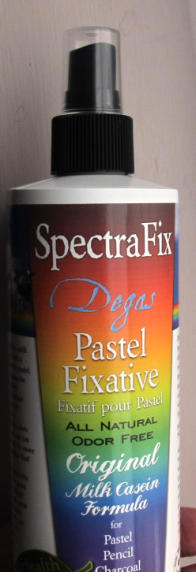 SpectraFix offers a different approach to fixing, using a casein (milk-based) binder in a non-pressurised, pump-action spray bottle, often favoured for its lower odour.
SpectraFix offers a different approach to fixing, using a casein (milk-based) binder in a non-pressurised, pump-action spray bottle, often favoured for its lower odour.Non-Aerosol / Alternative Binder Fixatives:
These offer an alternative to traditional solvent-based aerosols and are often favoured by those looking for lower odour or different formulations.
SpectraFix Degas Pastel Fixative:
This fixative is quite different as it's casein-based (derived from milk protein) and comes in a non-aerosol pump spray bottle. It's water-based (with alcohol) and marketed as non-toxic and low odour.
Many artists, particularly those sensitive to solvents or seeking more environmentally friendly options, appreciate SpectraFix. It typically dries to a very matte finish.
Being a pump spray, getting a very fine, even mist can take a little practice compared to an aerosol.
General Considerations When Choosing:
Availability and Budget: These practical factors will naturally play a role in your choice.
Your Specific Pencils and Paper: Some fixatives might perform slightly differently depending on whether your pencils are wax-based or oil-based, or the absorbency and texture of your paper.
Personal Preference for Finish: After testing, you might find you prefer the finish or working properties of one brand over another.
A Note on International Brands (e.g., Krylon from the USA):
You might see various other brands recommended in online forums or from artists in other countries (Krylon is a well-known example in the USA).
While some may be available via specialist import, it's often simpler to explore brands readily available in the UK and Europe to ensure consistency of supply and product suitability for your region.
The Most Important Step: Your Own Tests
I truly cannot emphasize this enough: regardless of brand reputation or recommendations, the only way to be certain how a fixative will perform with your specific materials, on your paper, with your application style, is to test it yourself on a sample piece first.
This step will save you potential disappointment and give you confidence when applying it to your finished artwork.
Using Fixative with Different Pencil Media
While the general application best practices we've discussed apply across the board, it's helpful to understand some specific considerations when using fixatives with different types of pencil media that are popular with artists:
1. Wax-Based Coloured Pencils
(Examples: Prismacolor Premier, Derwent Coloursoft, Derwent Artist)
Primary Uses of Fixative:
- Managing Wax Bloom: As we've discussed extensively on our Wax Bloom page, fixative is a key tool for preventing and managing the hazy film that can occur with these pencils, especially after heavy application or burnishing.
- Allowing Further Layering (Workable Fixative): If you've built up many layers and the surface has become slick and resistant to more pigment, a light coat of workable fixative can restore some tooth, allowing you to add more details or adjust colours.
- Final Protection: A final fixative will seal your finished wax-based pencil artwork, protecting it from smudges and helping to lock in the layers.
Considerations:
Because of the wax content, be especially mindful of applying light coats of fixative to avoid any pooling or overly wet application that might visibly interact with the wax.
Always test!
 This detailed landscape by Peter Weatherill demonstrates how a fixative such as SpectraFix can be used to add tooth back to slick coloured pencil areas, enabling further work. Peter was able to add more colour and detail to the trees and water after its application.
This detailed landscape by Peter Weatherill demonstrates how a fixative such as SpectraFix can be used to add tooth back to slick coloured pencil areas, enabling further work. Peter was able to add more colour and detail to the trees and water after its application.2. Oil-Based Coloured Pencils
(Examples: Faber-Castell Polychromos, Caran d'Ache Pablo, Lyra Rembrandt Polycolor)
Primary Uses of Fixative:
- Less Need for Wax Bloom Prevention: Since these pencils contain an oil-based binder, wax bloom is generally not an issue.
- Final Protection and UV Resistance: The main reason to use a final fixative with oil-based pencils is for overall surface protection against dust, moisture, smudging (though they smudge less readily than wax pencils), and for UV protection if the fixative offers it.
- Creating Tooth (Workable Fixative): Similar to wax pencils, if you've heavily burnished or blended oil-based pencils to a very slick surface, a workable fixative can sometimes help if you need to add more layers.
Considerations:
Oil-based pencils are generally very stable on the page, but a final fixative can offer peace of mind and enhanced longevity.
3. Pastel Pencils (and Soft Pastels)
Primary Uses of Fixative:
- Preventing Smudging: This is crucial for pastel pencils and soft pastels due to their powdery nature. Even slight contact can cause smudging.
- Building Layers (Workable Fixative): Workable fixative is often used between layers of pastel to bind the loose pigment to the paper. This allows you to apply more layers on top without disturbing the underlying ones and can help restore the paper's tooth.
- Final Protection: A final fixative is essential to protect the delicate surface of a finished pastel piece.
Key Challenge – Potential Colour Darkening or Dulling:
A common concern with fixing pastels is that the spray can sometimes make colours appear darker, deeper, or less vibrant, particularly lighter shades or when applied too heavily.
The fixative can essentially "bed down" the powdery pigment, reducing its light-scattering properties.
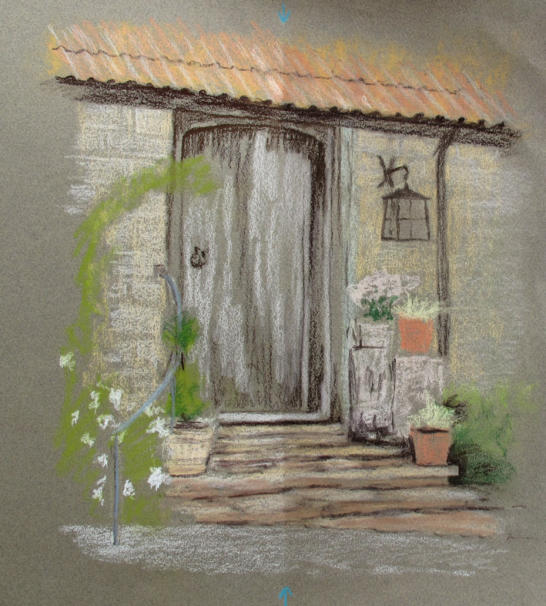 An example of how fixative can sometimes darken pastel pencil work. The right half of this doorway sketch was sprayed, resulting in visibly deeper tones compared to the untreated left half.
An example of how fixative can sometimes darken pastel pencil work. The right half of this doorway sketch was sprayed, resulting in visibly deeper tones compared to the untreated left half.Expert Advice (Jackie Simmonds' Wisdom):
Experienced pastel artists often differentiate their fixative application based on purpose.
- Between Layers: When using fixative during the painting process to allow for more layers, it can be applied a bit more liberally. The goal here is to saturate the existing pastel enough to bind it and restore tooth. Some initial darkening might occur, but subsequent pastel layers will cover it.
- For Final Protection: When spraying a completed pastel piece, the advice is to use multiple very light, almost mist-like coats. Allow each coat to dry completely before applying the next. This careful, patient approach minimizes colour shifts and helps preserve the vibrancy and sparkle of the pastel.
Restoring Contrast: After applying a final fixative to pastels, you might find you need to gently re-touch the very lightest highlights or darkest accents with your pencils to bring back the full range of contrast.
A Universal Reminder
No matter which pencil medium you're using, the way a specific fixative interacts with your particular brand of pencils, your chosen paper, and your individual application style can vary.
This is why the mantra remains: Always Test First!
A quick test on a scrap piece can tell you so much and prevent any unwanted surprises on your finished artwork.
Troubleshooting Common Fixative Problems
Even when you follow all the best practices for applying fixative, occasional issues can crop up.
Don't panic if this happens!
Many common problems are preventable with a bit more practice, or can at least be understood so you can avoid them next time.
Here are a few common fixative frustrations and how to tackle them:
Problem: Spattering, Uneven Spray, or Large Droplets
Likely Causes:
- Aerosol Can: Not shaking the can thoroughly enough before or during use; the nozzle being old, partially clogged, or dirty; holding the can at an incorrect angle (e.g., too horizontally when it needs to be upright).
- Pump Spray (Non-Aerosol): Inconsistent pumping action; nozzle issue; fixative too thick for the mechanism (less common with artist-grade products). Your original page noted the SpectraFix pump could be tricky and result in uneven drops if not handled carefully.
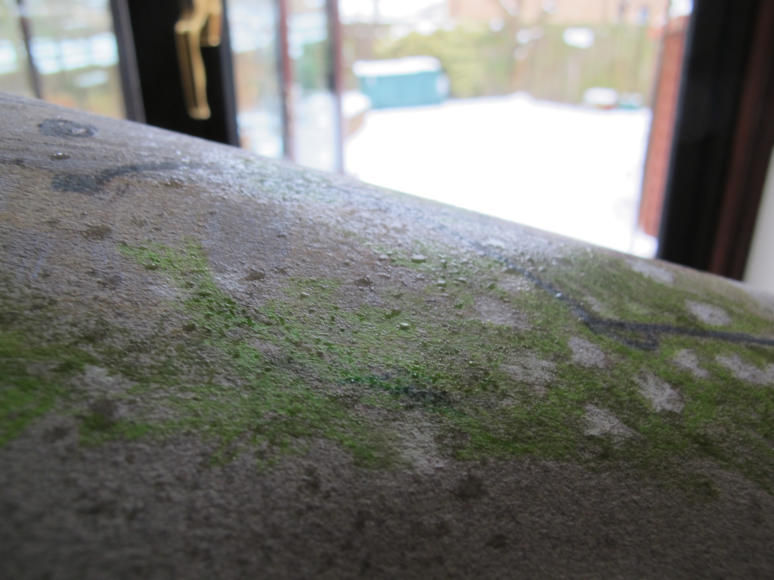 An example of an uneven initial spray from a pump-action fixative. These droplets often disappear as the fixative dries completely.
An example of an uneven initial spray from a pump-action fixative. These droplets often disappear as the fixative dries completely.Solutions and Prevention:
- Aerosols: Always shake the can very well as per the instructions (often for 1-2 minutes). Before spraying your artwork, do a quick test spray onto scrap paper away from your piece to ensure the nozzle is clear and spraying an even mist. Wipe the nozzle clean before and after use. Hold the can upright unless the instructions specify otherwise.
- Pump Sprays: Practice on scrap paper to get a feel for the pumping rhythm needed for an even mist. Ensure the nozzle is clean.
Problem: Pooling, Runs, or Very Wet Patches on the Artwork
Likely Causes:
- Spraying too close to the artwork's surface; applying too much fixative in a single pass or holding the spray in one spot for too long; moving too slowly across the surface.
Solutions and Prevention:
- Maintain the correct spraying distance (usually 20-30cm / 8-12 inches – check the can).
- Remember the golden rule: Multiple light coats are better than one heavy coat
- Use smooth, even, sweeping motions, starting and stopping the spray off the artwork
- If a run or pool occurs, resist the urge to touch or wipe it while it's wet! This often makes it worse. Allow it to dry completely. Sometimes the mark is less noticeable once fully dry. For very robust papers and light marks, some advanced careful lifting or sanding might be attempted by experienced artists, but it's risky. Prevention is the best cure.
Problem: Cloudiness, Fogging, or a Milky Appearance After Drying
Likely Causes:
- Spraying in very cold or very humid conditions (trapped moisture is a common culprit); applying coats that are too thick, preventing proper drying and curing; an incompatible fixative for the specific surface or medium.
Solutions and Prevention:
- Try to apply fixative in moderate temperatures and lower humidity if possible. Avoid damp or very cold rooms
- Apply thin, even coats and allow adequate drying time between them
- Always test on a scrap piece first to check for compatibility.
Problem: Significant Colour Shifts or Darkening (Beyond an Expected Subtle Deepening)
Likely Causes:
- The specific chemical formulation of the fixative interacting with certain pigments in your pencils; applying the fixative too heavily or too wetly. (Your original page noted some older concerns with certain brands affecting specific colours like reds and purples).
Solutions and Prevention:
- This is where testing is absolutely vital. Always test the fixative on all key colours used in your artwork (on the same paper) before committing to the final piece
- Apply multiple light coats. Heavy coats are more likely to cause noticeable shifts.
- If you are particularly concerned about colour fidelity, research fixatives known for having minimal impact (Lascaux, for instance, is often cited by artists in this regard, though it comes at a higher price).
Problem: Surface Remains Tacky or Sticky Long After Drying Time
Likely Causes:
- Fixative applied too thickly; insufficient drying time allowed between coats (if multiple were applied); high humidity during application or drying; the fixative itself might be old or a less compatible formulation for your specific pencil layers.
Solutions and Prevention:
- Apply thin coats
- Strictly follow recommended drying times (and even allow a bit longer in humid conditions).
- Ensure you're using fresh, good-quality fixative.
- If tackiness persists after ample drying time in good conditions, there may not be an easy fix. Prevention is key.
Problem: Fixative Doesn't Seem to "Work" (e.g., Pastels Still Smudge Very Easily)
Likely Causes:
- Not enough fixative applied (too few coats or coats applied too lightly/from too far away); the fixative isn't well-suited for the particular medium (e.g., a very light workable fixative might not fully bind very powdery soft pastels for final protection); extremely powdery pastel application that requires more substantial binding.
- Solutions and Prevention:
- Ensure you're applying an adequate number of light coats for the intended purpose (final vs. workable).
- Double-check that the fixative is recommended for your medium
- For very powdery pastels, you might need more substantial fixing, perhaps including workable fixative between layers and then a thorough (but still light-coated) final fixative application.
Learning to use fixative effectively is a skill that develops with practice.
Don't be discouraged by early hiccups. By understanding these common issues and always testing first, you'll gain confidence and achieve consistent, beautiful results.
Conclusion: Using Fixatives with Knowledge and Confidence
As we've explored in this guide, artist fixative sprays can be a genuinely valuable addition to your coloured pencil or pastel pencil toolkit.
Whether you're looking to protect your finished masterpieces from smudging, gain more working layers on a saturated surface, manage issues like wax bloom, or add UV protection for longevity, the right fixative, applied correctly, can make a significant difference.
The journey to using fixatives successfully comes down to a few key principles:
- Understand Your Tools: Knowing the difference between a workable fixative (for in-progress work) and a final fixative (for completed pieces) is the first vital step.
- Application is Key: Remember that multiple light, even coats are almost always better than one heavy application. Pay attention to your spraying distance, motion, and the drying times recommended by the manufacturer.
- Safety First, Always: Prioritise working in a well-ventilated area and follow all safety precautions outlined on the product label.
- The Golden Rule – Test, Test, Test!: I can't repeat this enough – always test a fixative on a scrap piece of your specific paper with your chosen pencils before ever applying it to your precious artwork. This is the single best way to avoid unwanted surprises and find what works best for you.
Don't be afraid to experiment (safely, of course!) with different types and brands of fixative as your experience grows. You'll soon discover which products and techniques best suit your artistic style and the materials you love to use.
With a little knowledge and careful practice, fixatives can move from being a source of uncertainty to becoming a trusted ally in creating and preserving your beautiful pencil artwork.
Happy (and safe) fixing!
